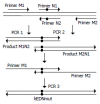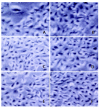Targeted ribonuclease can inhibit replication of hepatitis B virus
- PMID: 12532452
- PMCID: PMC4611332
- DOI: 10.3748/wjg.v9.i2.295
Targeted ribonuclease can inhibit replication of hepatitis B virus
Abstract
Aim: To study the effect of a novel targeted ribonuclease (TN), the fusion protein of HBVc and human eosinophil-derived neurotoxin (hEDN), on the HBV replication in vitro.
Methods: The gene encoding the targeted ribonuclease was cloned into pcDNA3.1 (-) to form recombinant eukaryotic expression vector p/TN. Control plasmids, including p/hEDN, p/HBVc, and p/TNmut in which a Lys113-Arg mutation was introduced by sequential PCR to eliminate the ribonuclease activity of hEDN, were also constructed. Liposome-mediated transfection of 2.2.15 cells by p/TN, p/TNmut, p/hEDN, p/HBVc, and pcDNA3.1 (-), or mock transfection was performed. After that, RT-PCR was used to verify the transgene expression. Morphology of the transfected cells was observed and MTT assay was performed to detect the cytotoxicity of transgene expression. Concentration of HBsAg in the supernatant of the transfected cells was measured using solid-phase radioimmunoassay.
Results: Transgenes were successfully expressed in 2.2.15 cells. No obvious cytotoxic effect of transgene expression on 2.2.15 cells was found. The HBsAg concentration in the p/TN transfected cells was reduced by 58 % compared with that of mock transfected cells. No such an effect was found in all other controls.
Conclusion: The targeted ribonuclease can inhibit HBV replication in vitro while it has no cytotoxicity on host cells. The targeted ribonuclease may be used as a novel antiviral agent for human HBV infection.
Figures





Similar articles
-
Inhibition of HBV targeted ribonuclease enhanced by introduction of linker.World J Gastroenterol. 2003 Jul;9(7):1504-7. doi: 10.3748/wjg.v9.i7.1504. World J Gastroenterol. 2003. PMID: 12854151 Free PMC article.
-
[Adenovirus-mediated delivery of targeted ribonuclease against HBV replication in vitro].Nan Fang Yi Ke Da Xue Xue Bao. 2006 Mar;26(3):279-83. Nan Fang Yi Ke Da Xue Xue Bao. 2006. PMID: 16546726 Chinese.
-
A promising alternative anti-HBV agent: the targeted ribonuclease.Int J Mol Med. 2010 Jul;26(1):51-6. doi: 10.3892/ijmm_00000434. Int J Mol Med. 2010. PMID: 20514422
-
Adenoviral-vector mediated transfer of HBV-targeted ribonuclease can inhibit HBV replication in vivo.Biochem Biophys Res Commun. 2008 Jul 4;371(3):541-5. doi: 10.1016/j.bbrc.2008.04.121. Epub 2008 May 1. Biochem Biophys Res Commun. 2008. PMID: 18455508
-
[Construction and expression of prokaryotic expression vector for pTAT-HBV targeted ribonuclease fusion protein].Xi Bao Yu Fen Zi Mian Yi Xue Za Zhi. 2003 Jan;19(1):49-51. Xi Bao Yu Fen Zi Mian Yi Xue Za Zhi. 2003. PMID: 15132905 Chinese.
Cited by
-
Neonatal oxygen increases sensitivity to influenza A virus infection in adult mice by suppressing epithelial expression of Ear1.Am J Pathol. 2012 Aug;181(2):441-51. doi: 10.1016/j.ajpath.2012.05.005. Epub 2012 Jun 5. Am J Pathol. 2012. PMID: 22677423 Free PMC article.
-
Gene therapeutic approaches to inhibit hepatitis B virus replication.World J Hepatol. 2015 Feb 27;7(2):150-64. doi: 10.4254/wjh.v7.i2.150. World J Hepatol. 2015. PMID: 25729471 Free PMC article. Review.
-
Capsid-Targeted Viral Inactivation: A Novel Tactic for Inhibiting Replication in Viral Infections.Viruses. 2016 Sep 21;8(9):258. doi: 10.3390/v8090258. Viruses. 2016. PMID: 27657114 Free PMC article. Review.
-
Anti-HBV effect of TAT- HBV targeted ribonuclease.World J Gastroenterol. 2003 Jul;9(7):1525-8. doi: 10.3748/wjg.v9.i7.1525. World J Gastroenterol. 2003. PMID: 12854156 Free PMC article.
-
Abundance of RNase4 and RNase5 mRNA and protein in host defence related tissues and secretions in cattle.Biochem Biophys Rep. 2016 Sep 23;8:261-267. doi: 10.1016/j.bbrep.2016.09.001. eCollection 2016 Dec. Biochem Biophys Rep. 2016. PMID: 28955965 Free PMC article.
References
-
- Ganem D, Varmus HE. The molecular biology of the hepatitis B viruses. Annu Rev Biochem. 1987;56:651–693. - PubMed
-
- Lau JY, Wright TL. Molecular virology and pathogenesis of hepatitis B. Lancet. 1993;342:1335–1340. - PubMed
-
- Hoofnagle JH. Therapy of viral hepatitis. Digestion. 1998;59:563–578. - PubMed
-
- Hilleman MR. Overview of the pathogenesis, prophylaxis and therapeusis of viral hepatitis B, with focus on reduction to practical applications. Vaccine. 2001;19:1837–1848. - PubMed
Publication types
MeSH terms
Substances
LinkOut - more resources
Full Text Sources

